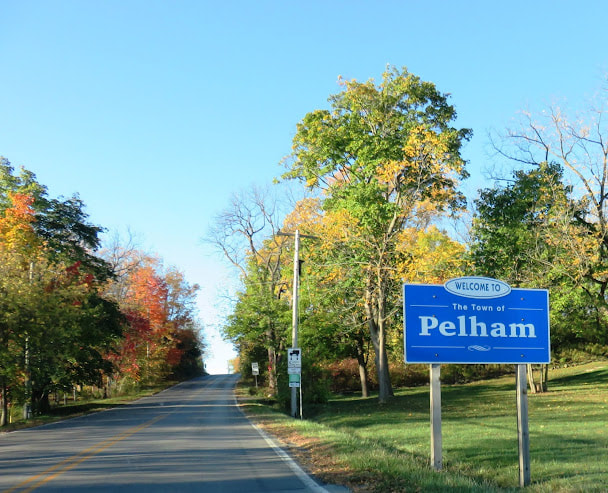Yours to discover.
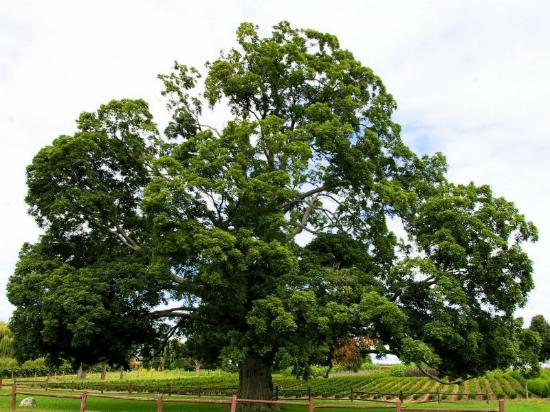
As Mike Hackman wrote, "This Maple remembers Columbus’ time with the first pioneers and trappers in Canada and is still alive. It is 24.5 metres (80 feet) tall with a crown circumference of 38 metres (125 feet), with the trunk itself measuring 6 metres (20 feet) at the base.
The Comfort Maple tree is an individual sugar maple (Acer saccharum).The tree is estimated (not based upon a complete ring count) to be about 500 years old.
It was named after the Comfort family, who acquired the land in 1816. The land around the tree was donated by Miss Edna Eleanor Comfort to the Niagara Peninsula Conservation Authority on April 30, 1961, area in the Town of Pelham, Ontario.
There are more such old trees in Ontario.
For example the Dwarfed cliff cedar, Thuja occidentalis, which was more than 1,320 years old, still lives in the Niagara region. So it started sprouting around 690 AD. At a time when even the Vikings didn’t know about America."
The Comfort Maple tree is an individual sugar maple (Acer saccharum).The tree is estimated (not based upon a complete ring count) to be about 500 years old.
It was named after the Comfort family, who acquired the land in 1816. The land around the tree was donated by Miss Edna Eleanor Comfort to the Niagara Peninsula Conservation Authority on April 30, 1961, area in the Town of Pelham, Ontario.
There are more such old trees in Ontario.
For example the Dwarfed cliff cedar, Thuja occidentalis, which was more than 1,320 years old, still lives in the Niagara region. So it started sprouting around 690 AD. At a time when even the Vikings didn’t know about America."
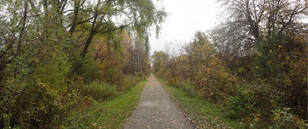
Steve Bauer Trail, Pelham, Ontario
The Steve Bauer Trail in Pelham, Ontario is named in honour of Steve Bauer, a former professional road bicycle racer.
He won a silver medal in the men's cycling road race at the 1984 Summer Olympics in Los Angeles.
The Steve Bauer Trail in Pelham, Ontario is named in honour of Steve Bauer, a former professional road bicycle racer.
He won a silver medal in the men's cycling road race at the 1984 Summer Olympics in Los Angeles.
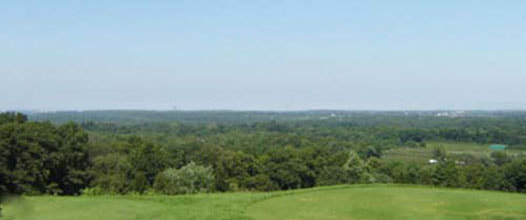
The Fonthill Kame
A kame is a giant hill and the Fonthill Kame, located in Pelham, Ontario is approximately 6km (4 miles east to west) and 3km (2 miles north to south). It rises approximately 250 feet above the surrounding area, an has the highest elevation in the Niagara Region.
The Fonthill Kame is comprised mainly of sand and gravel deposited by the retreating glaciers over 10,000 years ago.
A kame is a giant hill and the Fonthill Kame, located in Pelham, Ontario is approximately 6km (4 miles east to west) and 3km (2 miles north to south). It rises approximately 250 feet above the surrounding area, an has the highest elevation in the Niagara Region.
The Fonthill Kame is comprised mainly of sand and gravel deposited by the retreating glaciers over 10,000 years ago.
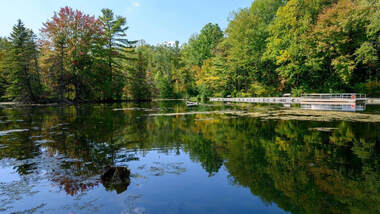
St. Johns Conservation Area
Located within the Niagara Escarpment and Twelve Mile Creek valley, this natural area provides a tranquil setting for wildlife and visitors. A hot spot for seasonal trout fishing, St. Johns is also known for bird watching and nature education.
Boasting four trails of varying lengths and difficulty: The Tulip Tree, Sassafras, Horseshoe, and St. Johns Ridge trails each wind their way through this large interior forest. Some trails are wheelchair and stroller accessible.
St. Johns is a sensitive ecosystem, so please help us protect it by keeping to the trails, and refraining from removing any plants or animals (including minnows, tadpoles and frogs).
Healthy Ecosystems and parks = healthy environments for us all. All species and their populations at the site work together and are dependent on one another with a balance between producers and consumers. If some are removed, the balance is offset. For example, if turtles, tadpoles, frogs which eat algae, are removed from the pond at St. Johns, algae along with warm temperatures and excessive nutrients (i.e. from food feed to animals) will increase. Algae blooms can be harmful to fish and aquatic species.
As a result to help protect these important areas and functions, we thank you for taking memories and pictures only, and keeping wildlife and plants in the wild.
A UNIQUE SITE FOR HIKING & NATURE APPRECIATION ALL YEAR ROUND.
FISHING OPPORTUNITIES ARE AVAILABLE FROM THE 4TH SATURDAY IN APRIL TO END OF SEPTEMBER (RAINBOW TROUT SEASON) ONLY.
PLEASE CONSIDER CATCH AND RELEASE ANGLING TO ENSURE FISHING OPPORTUNITIES FOR THE COMMUNITY THROUGHOUT THE SEASON.
St. Johns Conservation Area
Located within the Niagara Escarpment and Twelve Mile Creek valley, this natural area provides a tranquil setting for wildlife and visitors. A hot spot for seasonal trout fishing, St. Johns is also known for bird watching and nature education.
Boasting four trails of varying lengths and difficulty: The Tulip Tree, Sassafras, Horseshoe, and St. Johns Ridge trails each wind their way through this large interior forest. Some trails are wheelchair and stroller accessible.
St. Johns is a sensitive ecosystem, so please help us protect it by keeping to the trails, and refraining from removing any plants or animals (including minnows, tadpoles and frogs).
Healthy Ecosystems and parks = healthy environments for us all. All species and their populations at the site work together and are dependent on one another with a balance between producers and consumers. If some are removed, the balance is offset. For example, if turtles, tadpoles, frogs which eat algae, are removed from the pond at St. Johns, algae along with warm temperatures and excessive nutrients (i.e. from food feed to animals) will increase. Algae blooms can be harmful to fish and aquatic species.
As a result to help protect these important areas and functions, we thank you for taking memories and pictures only, and keeping wildlife and plants in the wild.
A UNIQUE SITE FOR HIKING & NATURE APPRECIATION ALL YEAR ROUND.
FISHING OPPORTUNITIES ARE AVAILABLE FROM THE 4TH SATURDAY IN APRIL TO END OF SEPTEMBER (RAINBOW TROUT SEASON) ONLY.
PLEASE CONSIDER CATCH AND RELEASE ANGLING TO ENSURE FISHING OPPORTUNITIES FOR THE COMMUNITY THROUGHOUT THE SEASON.
Niagara Region provides health and social services to Pelham residents.
You can learn more about the Region's Public Health and Social Service Programs in the Community by visiting their website: www.niagararegion.ca/living/health . Here you can find information about the available programs and services that you may need to access such as:
You can learn more about the Region's Public Health and Social Service Programs in the Community by visiting their website: www.niagararegion.ca/living/health . Here you can find information about the available programs and services that you may need to access such as:
- Clinics, courses, and classes
- Vaccinations
- Dental health
- Mental health
- Home health hazards

